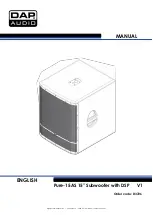
Page 4
The “
Reference
150
” has twin sophisticated Digitally Accurate Microprocessor controlled
crossover circuits (D.A.M.P. 2nd generation), which incorporate a digital display so that the upper
response limit can be set in musically accurate variable increments between 20hz and 120hz. An
LFE bypass facility is activated at one end of the Lro level controls travel which allows the input
signal to bypass the filter circuit at a fixed 200hz roll-off. The LFE bypass is used where an
already filtered signal is offered to the low level input sockets. An example of this would be a sub
output from a dedicated control pre-amplifier such as found in a Home Cinema system. With twin
crossovers you have the ability to set the crossover point independently for the High Level/Line
Level inputs and the LFE input. Accurately setting your system up for Music and Home Cinema
has never been easier.
There are separate Crossover and Gain controls for HI/LO and LFE level inputs, an LFE bypass
setting and audibly transparent "Dynamic Intelligent Protection" (
D.I.P.
) circuit, which monitors
the output stages for clipping and limits the cone movement if the amplifier is being over-driven.
A professional Speakon connector is standard for the “
Reference
150
’s” stereo High Level
input utilising an approved touch proof design to cater for potentially high voltages that can be
connected to it. The “
Reference
150
” also offers unbalanced Line-Level gold plated RCA
connectors to cater for LO/LFE inputs and LFE loop-out.
Incorporated within this model is our 2nd generation DAMP® offering full digital adjustments of all
features but with that all important analogue feel. All the system functions and adjustments can
be made using a single data rotary control knob. In addition to the main Data rotary control we
provide a further 4 rotary controls for instant access to FREQ and GAIN for the twin independent
crossovers. These 4 rotary controls also provide the means to select and store 4 user presets.
Use of the controls could not be simpler. For the Data control push to select menu item and turn
to adjust. User presets can be selected by a single push on the appropriate rotary control and
push and hold for storing new settings. (See page 6 memories)
Reference
150 MkII
User’s Manual
14/12/2005 (Ref – 150)
Page 13
Connect your subwoofer to your audio system using the low level phono interconnect supplied to
the LFE input or the supplied high level lead. Both connections can be made simultaneously.
Please refer to the separate instructions on
page 9
for the high level lead connection.
Please ensure:
All control settings are as follows:
gains at –99, 0° phase, and 120hz frequency contour
on first power-up.
(Default factory setting)
Music Material
After powering up the sub, audition a piece of music you are familiar with and set the main audio
system volume to your normal listening level. Slowly increase the appropriate gain control on
your
Reference
150
to read -40. You should now be experiencing sub-bass in your overall mix.
How much bass output is determined by the setting of the gain control relevant to each input.
Now adjust the relevant frequency contour until you hear the subwoofer output the bandwidth of
bass frequencies your main speakers lack. For example, most large main speakers start to roll
off the bass output at around 40hz – 80hz so this is where the subwoofer should take over.
Movies
After powering up the sub, audition a movie you are familiar with and set the main audio system
volume to your normal listening level. Slowly increase the LFE gain control on your
Reference
150
to read -40. You should now be experiencing the LFE channel. How much
output is determined by the setting of the gain control relevant to the LFE input.
Now adjust the LFE frequency contour until you hear the subwoofer output the LFE bandwidth.
In the case of LFE the setting to start at is 80hz.
Further fine tweaking can be made as you become more familiar with the controls and
adjustments.
SET-UP HINTS & TIPS
Reference
150 MkII
User’s Manual
Note:
Be sure to store your settings as you make adjustments so that they can be recalled in the future.
By doing this you can save settings which are best suited for your own tastes of music or movie
content.
Resetting Factory Default Data:
Should you wish to reset the system back to factory default state then turn the power off and
hold down the DATA button and power up. All settings will be returned back to Factory Default.
14/12/2005 (Ref – 150)


























